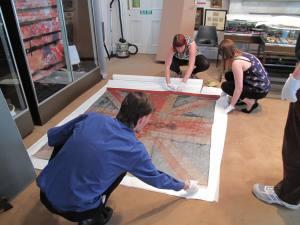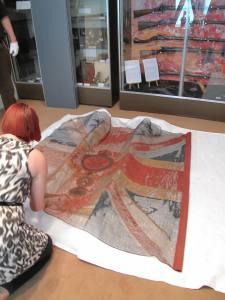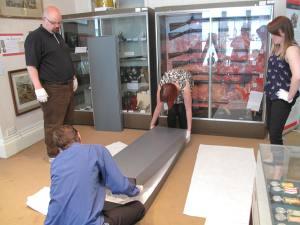
Thanks to the team at the Museum of the Black Watch for this insight into some of the challenges of conservation. I mean, how hard could it be?
That’s a question some of us asked ourselves when we heard we would be packing up a couple of 200-year-old textiles last week. The answer, as it turns out, is ‘very’!
Last week we took down and packed up the Colours used during the Napoleonic Campaigns, and flown at the Battle of Quatre Bras and Waterloo. They have been hanging in the Museum for decades. These Regimental flags, after so many years of suspension, are definitely in need of some attention if we hope to preserve them for future generations (which we do!).They are being sent to a professional conservator who will mount them in order to provide extra support and stability, and allow them to be more visible to the visitor.
The Colours have been conserved in the past, many decades ago. At that time the layers of silk were sandwiched between two layers of net, with the net being the same color as the silk. Over the years the silk has continued to disintegrate, but the net has worn better. So most of what you see today is the net (with small fragments of silk in places) with the embroidery and other detailing in situ. However, the net is dirty and brittle in places, and the remaining silk fragments are very fragile – making packing the Colours a fraught task!
It may sound straightforward, moving and packing two pieces of cloth (nearly 2 meter square pieces of cloth, for the record), but this was no easy feat. With detailed instructions from the conservator, plenty of pairs of white gloves to protect the material from the oils on our skin, and a hefty stack of tissue paper, a team of five of us museum staff set about accomplishing the task before us.

We started with the Sovereign’s Colour, which you can see in the photo to the left. First off, the pike from which the Colour hangs had to be taken down from the ceiling and the actual flag removed from the pole. We laid the Colour down on some tyvek (a synthetic material that is good for many uses in museums thanks to its neutral ph level) covered in tissue paper. Acid-free tissue is layered between the folds of textiles when you pack them up in order to protect the fabric. Once we had laid them out on the tissue and tyvek, we lifted the tyvek and positioned the center of the colours in a long textile box. The aim of the game was to put as little pressure as possible on the actual textile itself. We had to carefully fold the sides of the colours into the box (again, with layers of acid-free tissue in between every fold).

We created ‘sausages’ (rolls of tissue paper) to soften the folds of the fabric and try to prevent creasing, and placed tissue clouds in between layers of material to take the weight of the fabric.
After about two hours of strategising, rolling and folding tissue paper, and trying our best to touch the colours as little as possible, we managed to get both flags into their boxes. They are now safely in the hands of the conservator.
In a few weeks we will be starting to pack up all the artefacts in the museum, getting everything ready to move to its temporary storage place during the refurbishment. The packing of the colours was one of the first challenges, but no doubt the coming weeks will see us exercising all our creative powers to come up with ways to safely pack everything from enormous paintings and old, fragile documents to sharp swords and miniature medals!

Entry Fee: ? They reopen after redevelopment in Spring 2013
Be sure to check out their website where you can ADOPT AN ARTEFACT, what a lovely idea.
